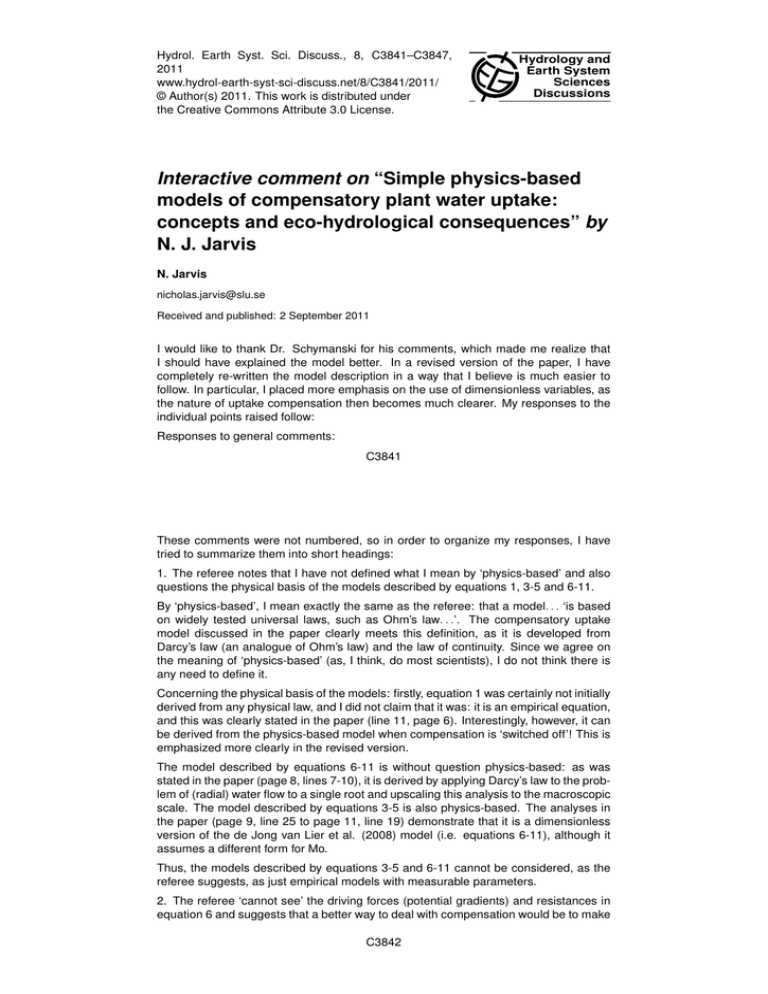Printer-friendly Version
advertisement

Hydrol. Earth Syst. Sci. Discuss., 8, C3841–C3847, 2011 www.hydrol-earth-syst-sci-discuss.net/8/C3841/2011/ © Author(s) 2011. This work is distributed under the Creative Commons Attribute 3.0 License. Hydrology and Earth System Sciences Discussions Interactive comment on “Simple physics-based models of compensatory plant water uptake: concepts and eco-hydrological consequences” by N. J. Jarvis N. Jarvis nicholas.jarvis@slu.se Received and published: 2 September 2011 I would like to thank Dr. Schymanski for his comments, which made me realize that I should have explained the model better. In a revised version of the paper, I have completely re-written the model description in a way that I believe is much easier to follow. In particular, I placed more emphasis on the use of dimensionless variables, as the nature of uptake compensation then becomes much clearer. My responses to the individual points raised follow: Responses to general comments: C3841 These comments were not numbered, so in order to organize my responses, I have tried to summarize them into short headings: 1. The referee notes that I have not defined what I mean by ‘physics-based’ and also questions the physical basis of the models described by equations 1, 3-5 and 6-11. By ‘physics-based’, I mean exactly the same as the referee: that a model. . . ‘is based on widely tested universal laws, such as Ohm’s law. . .’. The compensatory uptake model discussed in the paper clearly meets this definition, as it is developed from Darcy’s law (an analogue of Ohm’s law) and the law of continuity. Since we agree on the meaning of ‘physics-based’ (as, I think, do most scientists), I do not think there is any need to define it. Concerning the physical basis of the models: firstly, equation 1 was certainly not initially derived from any physical law, and I did not claim that it was: it is an empirical equation, and this was clearly stated in the paper (line 11, page 6). Interestingly, however, it can be derived from the physics-based model when compensation is ‘switched off’! This is emphasized more clearly in the revised version. The model described by equations 6-11 is without question physics-based: as was stated in the paper (page 8, lines 7-10), it is derived by applying Darcy’s law to the problem of (radial) water flow to a single root and upscaling this analysis to the macroscopic scale. The model described by equations 3-5 is also physics-based. The analyses in the paper (page 9, line 25 to page 11, line 19) demonstrate that it is a dimensionless version of the de Jong van Lier et al. (2008) model (i.e. equations 6-11), although it assumes a different form for Mo. Thus, the models described by equations 3-5 and 6-11 cannot be considered, as the referee suggests, as just empirical models with measurable parameters. 2. The referee ‘cannot see’ the driving forces (potential gradients) and resistances in equation 6 and suggests that a better way to deal with compensation would be to make C3842 direct use of an Ohm’s law analogue. As mentioned above, equation 6 actually is derived from Ohm’s (Darcy’s) law solved for radial flow. However, this may not be so obvious, because the analysis of the highly non-linear flow problem has been simplified and made tractable by introducing the matric flux potential (Kirchoff transform). 3. The referee ‘cannot see’ where in the derivation of the model represented by equation 6-11 compensatory uptake is introduced and what happens when it is neglected. Compensation was not introduced in the original formulation, as it is only implicit in the model. In the revised version of the model description, I have placed more emphasis on the dimensionless version of the model, since it can be used to illustrate explicitly the contribution and effects of compensation. I have also modified figure 1 to better illustrate what happens when compensation is neglected. 4. The referee cannot see how varying the effective root length alone can represent compensation. Equation 13 shows which parameters influence compensation. One of these is the total (effective) root length. Obviously, compensation does not only depend on root length, but varying this parameter is just a convenient way to introduce different degrees of compensation for comparative purposes (keeping the other parameters involved constant). 5. The referee cannot see the relevance of hydraulic lift for compensatory uptake. I agree that this was not well explained. In fact, the model suggests that hydraulic lift can be considered as an extreme form of compensation. I have clarified the relationship between compensation and hydraulic lift in the revised version of the paper. 6. The referee has some doubts whether the root distribution used is characteristic for phreatophytic vegetation. C3843 Yes, I can imagine that this could be the case since, for example, equation 17 is not flexible enough to represent bimodal root distributions. However, the main point I wanted to make is that only a small fraction of roots in contact with groundwater (or the capillary fringe) is sufficient to give qualitatively reasonable simulations, but only if compensation is modeled. 7. The referee suggests that a better ‘reality check’ than comparisons with measured discharges would be to compare the simulation results with the Budyko curve to see which model fits better and which can explain some of the scatter around the curve. I did originally consider this, but decided not to, as I am only simulating eight locations. The Budyko curve is itself only an empirical relationship, and the scatter around it (which is considerable) is explained by variations in soil and vegetation properties, many of which have been held constant in my simulations (I assume an identical soil type for example). Such a comparison would also suffer from the same scale problem I encounter when comparing with measured river discharges (the curve is derived from data on large catchments, whereas I simulate a soil profile). Having said this, my simulations do fall within the scatter observed in Budyko-type plots (if they are interested, readers can plot this for themselves from the data given in Table 2). The observed scatter is, of course, much too large to say which of the models is best. In other words, it is just as inconclusive on this point as the results shown in fig.9. But the point of this exercise was to show that the simulated water balances are quite reasonable and not to try to identify which model was best (as I wrote, such a comparative validation exercise is not possible with this kind of data). 8. The referee suggests that these simulations suffer from an error in the mass balance (he calculates that at one site, the actual evapotranspiration is three times larger than the precipitation). The referee is mistaken. The mass balance errors in the simulations are negligible. As was stated in the paper (page 22, lines 6 and 10), it is the ratio between simulated C3844 actual and potential transpiration (and not evaporation) that is relatively constant across the aridity gradient (between 0.84 and 0.92 at the eight sites). Responses to specific comments: 1. As was stated (page 6, line 11), this equation is empirical. The relationship between this model and the physics-based approach is more clearly explained in the revised paper. 2. Yes, the nature of compensation is explained and defined more clearly in the revised version of the paper, with the help of the dimensionless form of the model. 3. This part of the model description has been completely re-written. The nature of compensation and how it is described by the model is now more clearly explained. 4. the compensation factor is explicitly defined in physical terms by equation 13. 5. Yes, this was a typo that has now been corrected. I have also added an equation defining this parameter. 6. The variables (K and h) included in this expression both have an obvious physical meaning, but the matric flux potential is not a physical law: it is just introduced as a mathematical convenience to help solve the flow problem. 7. Mo was defined in physical terms in connection to equation 6 (page 8, line 13). 8. Equations 11 and 15 represent two different ways of calculating Mo in the uptake model described by equations 6 and 7. The effects of compensation can be seen explicitly in the dimensionless form of the model. This is described in more detail in the revised version. 9. Please see my response to one of the referee’s general comments which was identical 10. I have added a definition in the revised version (it is simply the water flux across the C3845 bottom boundary of the profile). The results show that capillary rise is strongly affected by the choice of water uptake model (see fig. 5 and accompanying text). 11. I have not read Specht (1972), but yes, it does sound similar. However, I don’t avoid stress in my simulations: it is just not allowed to exceed a critical value. But I anyway cited three other papers (on lines 14 and 15) that used quite a similar approach to mine. The reference to the two papers on lines 11 and 12 was intended as more of a general reference to the concept of the optimality principle in water balance modeling. 12. Please see my response to one of the referee’s general comments which was identical. 13. Yes (except that an interception routine was added and LAI varied seasonally). This was already stated on page 18, lines 16-22. 14. It’s correct as written. 95% root depths were first estimated from the data (see lines 20-22), and then equation 17 was subsequently used to calculate both 99% root depths (note: 99% root depth=95% root depth*1.538) and Beta from these estimates. 15. There is no error. Please see my response to one of the referee’s general comments which was identical. 16. I deleted these sentences, which I agree were confusing. The improved description of the model in the revised version should clarify what was meant. 17. the compensation factor is given by equation 13. Thus, in addition to the plant parameters that influence potential transpiration (e.g. leaf area index, unstressed stomatal conductance), compensation is controlled by soil hydraulic properties (Mmax), root length and (less importantly) root diameter. These are all, in principle, measurable, although as I discussed in the paper, the effective fraction of the total root length may be difficult to estimate independently. Table 1 shows all the parameters in the model. C3846 I fully agree with the comment about leaf area and root distributions changing with time: the final paragraph of the paper discusses just this point. Mo was defined in physical terms in connection to equation 6 (page 8, line 13). Although it has an exact physical meaning (the matric flux potential at the root surface), Mo cannot be measured with present methods and technologies (as far as I know). In his general comments, the referee pointed out that just because the parameters of a model can be measured does not mean that the model is physics-based: this example with Mo demonstrates that just because the parameter has a clear physical meaning, does not necessarily mean that it is measurable! 18. I am sure that the improved description of the model will help resolve these difficulties. Concerning the question of bias, I assumed that the physics-based approach parameterized from literature data should represent reality better than an empirical model which is, in principle, incorrect. For the first case study, literature data do strongly support this contention. However, I agree that ‘confirm’ is probably too strong a word to use given the qualitative nature of the ‘reality checks’. I have changed this to ‘suggest’. 19. Please see my response to one of the referee’s general comments which was identical. Interactive comment on Hydrol. Earth Syst. Sci. Discuss., 8, 6789, 2011. C3847
